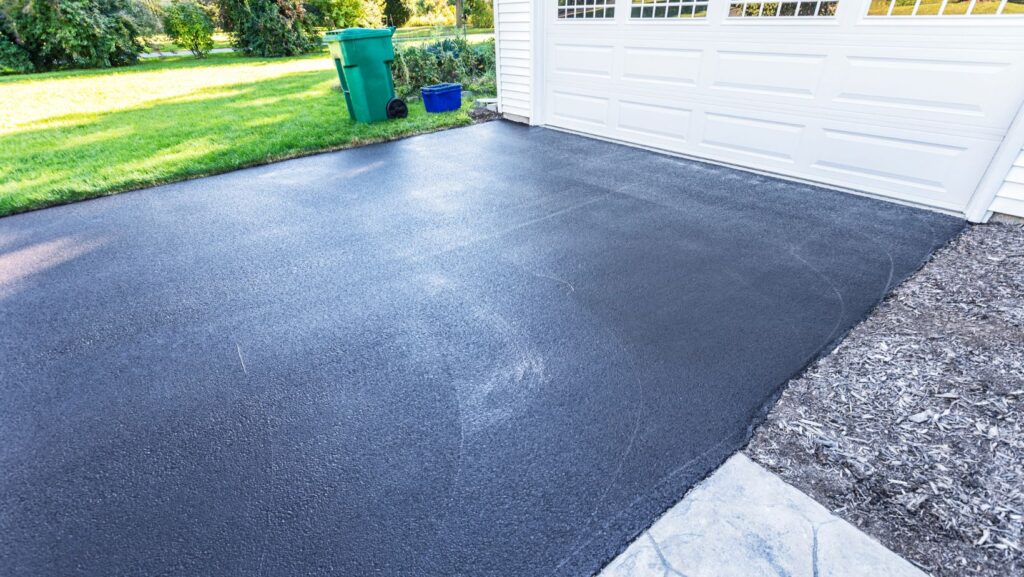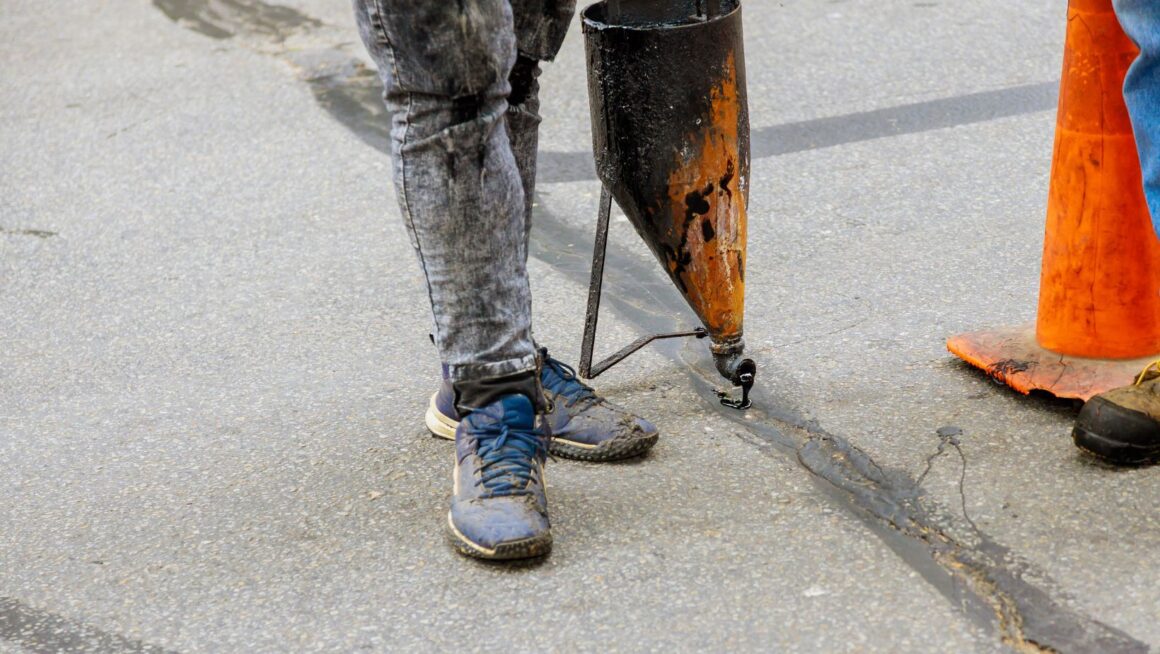
Hairline cracks, dark stains, and salt damage don’t happen overnight. They creep in as moisture and contaminants work their way into untreated concrete. Sealing is a simple step that can dramatically extend the life and look of your driveway, patio, shop floor, or Land Scaping project. This guide explains what sealing actually does, when to apply it, and how often to maintain it—so you can protect your concrete without overspending.
What Sealing Really Does
Concrete is porous. Water, de-icing salts, oil, and other contaminants can soak into the surface, leading to staining, freeze-thaw damage, corrosion of any embedded steel, and surface scaling. Sealers reduce that absorption.
There are two main categories:
- Penetrating sealers: Products like silane, siloxane, and siliconate soak into the concrete and chemically bond within the pore structure. They don’t change the surface texture or gloss and remain breathable.
- Film-forming sealers: Acrylics, polyurethanes, and epoxies create a thin protective film on top. They can add sheen and color enhancement, but may reduce breathability and can be more sensitive to UV and hot-tire pickup, depending on the chemistry.
Benefits and Trade-Offs
Pros
- Extends service life by limiting water, salt, and oil penetration.
- Improves stain resistance and makes cleaning faster.
- Enhances appearance (gloss or color “pop” with certain films).
- It can reduce dusting on older slabs and help resist freeze-thaw damage.
Cons
- Reapplication is required; intervals vary by product and exposure.
- Film-formers can be slippery when wet without traction additives.
- Trapped moisture or improper prep can cause whitening, blushing, or peeling.
- Low-quality products may yellow or wear unevenly under UV and traffic.
The key is matching the sealer to your use case: traffic level, climate, and aesthetic goals.
When to Seal New and Existing Concrete
New concrete
- Wait for curing: Most manufacturers recommend at least 28 days after placement before applying a long-term sealer, unless the product is explicitly a cure-and-seal.
- Confirm dryness: Perform a simple plastic sheet test—tape down a clear plastic sheet for 24 hours. If condensation forms, wait longer.
- Pick a weather window: Aim for surface and air temperatures between roughly 50–90°F with no rain in the forecast for 24 hours. Avoid direct midday sun for film-formers to reduce flash-off.
Existing concrete
- Clean first, then inspect: Degrease, pressure-wash, and let it dry. If water no longer beads on the surface, if stains soak in quickly, or if the slab shows early scaling/efflorescence, it’s time to seal.
- Test a small area: Apply a test patch in an inconspicuous spot to confirm appearance and adhesion.
How Often Should You Reseal?
Intervals depend on the chemistry, exposure, climate, and surface prep. Use this as a planning baseline:
| Sealer type | Typical locations | Recoat interval | Notes |
| Silane/Siloxane (penetrating) | Driveways, sidewalks, parking decks | 5–10 years | Breathable; strong salt and water repellency |
| Siliconate (penetrating) | Interior slabs, light-duty exterior | 3–7 years | Often economical; moderate repellency |
| Acrylic (film-forming) | Decorative patios, stamped concrete | 1–3 years | Enhances color/gloss; may need slip additive |
| Polyurethane (film-forming) | Garages, shops, commercial floors | 3–7 years | Good abrasion/chemical resistance |
| Epoxy (film-forming) | Interior floors only | 5–7 years | Very durable indoors; not UV-stable unless topcoated |
Snow-belt driveways that see de-icing salts and plow abrasion may be on the short end of these ranges. Sheltered patios in mild climates can last longer.
Choose the Right Sealer for Your Surface
- Use case and traffic: For driveways and sidewalks in freeze-thaw zones, a breathable penetrating sealer is usually the safest bet. For decorative stamped patios where you want color depth and shine, a quality acrylic may be ideal.
- Breathability: If moisture vapor can’t escape, film-formers risk whitening or delamination. Penetrating sealers maintain vapor transmission.
- Finish and safety: Gloss looks great, but can be slick; ask about traction additives and pick a low-sheen resin if slipperiness concerns you.
- UV and yellowing: Acrylics formulated for exterior use include UV stabilizers; epoxies generally do not and require a UV-stable topcoat outdoors.
- Compliance and odor: Check VOC rules in your state and whether you need low-odor water-based options.
- Validation: Look for products tested under recognized protocols (e.g., NCHRP 244 for chloride screening of penetrants).
Step-by-Step: How to Seal Concrete
- Prep the surface: Remove oil and stains with a degreaser. Treat rust separately. Rinse thoroughly. Pressure-wash and let the slab dry completely. Most sealers require a dry surface. For smooth, power-troweled interiors being coated with film-formers, mechanical abrasion or etching may be required for adhesion. Follow the product’s profile spec.
- Check conditions: Confirm substrate and ambient temperature within the product range. Ensure no rain, heavy dew, or condensation risk during cure. Measure humidity if recommended; avoid sealing in high wind or direct, harsh sun for film-formers.
- Mask and protect: Mask adjacent walls, doors, plants, and expansion joints as needed. Have a plan for pets and foot traffic during the cure.
- Apply correctly: Penetrating sealers: Use a low-pressure sprayer and a broom/back-roll to distribute evenly. Apply to saturation without puddling. Film-formers: Apply thin, even coats by roller or sprayer. Two thin coats beat one heavy coat.
- Respect coverage and dwell: Follow the labeled spread rate. Over-application can cause issues ranging from streaking to peeling (films) or darkening (penetrants). Maintain any required “wet” dwell time for penetrants before back-rolling.
- Cure and test: Block off the area. Light foot traffic may be allowed within hours; vehicle traffic typically waits 24–72 hours, depending on the product. After curing, sprinkle water. Beading indicates good repellency.
- Maintain: Clean periodically with pH-neutral cleaners. Avoid harsh acids or pressure-washing too close to film-formers.
DIY or Hire a Pro?
DIY makes sense if
- You have a small, straightforward area with minimal staining.
- You’re applying a penetrating sealer that is forgiving and breathable.
- You’re comfortable with surface prep and have a clear weather window.
Consider a professional if
- The slab shows scaling, previous sealer failure, or moisture issues that require testing and remediation.
- You want a film-forming system in a garage or commercial space where adhesion, slip resistance, and chemical exposure matter.
- You need crack repair, joint work, or color restoration on decorative concrete.
Budget ranges (ballpark, materials plus labor will vary by region and complexity)
- Penetrating sealers: roughly $0.75–$2.00 per sq. ft. installed.
- Acrylic film-formers: roughly $1.00–$3.00 per sq. ft. installed.
- High-performance polyurethanes/epoxies: often $3.00–$7.00+ per sq. ft. installed, depending on system build.

Ask about product data sheets, test standards, and a written workmanship warranty. A reputable contractor will explain surface prep, coverage rates, and expected recoat timelines for your climate.
Seasonal and Regional Factors to Weigh
- Freeze-thaw and salts: In northern climates, prioritize penetrating sealers with strong salt screening before winter. Reseal more frequently on driveways exposed to de-icers.
- Coastal environments: Salt spray drives chlorides into concrete; penetrating silanes are favored for exterior slabs and structural elements near the coast.
- Hot, sunny regions: UV exposure can age certain film-formers faster; choose UV-stable resins and avoid midday application.
- Shaded, damp sites: Mold and algae can make surfaces slick. Keep them clean and consider lower-sheen films with a traction additive or stick with penetrants.
Bottom Line
Sealing is preventive maintenance, not decoration alone. Done right, it keeps water and salts out, makes cleanup easier, and helps your concrete look good for years. Match the chemistry to your surface and climate, respect prep and cure, and set a realistic reseal schedule. If you prefer a hands-off approach, a qualified local professional can test moisture, recommend the right product, and apply it safely with warranty-backed results.



